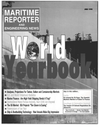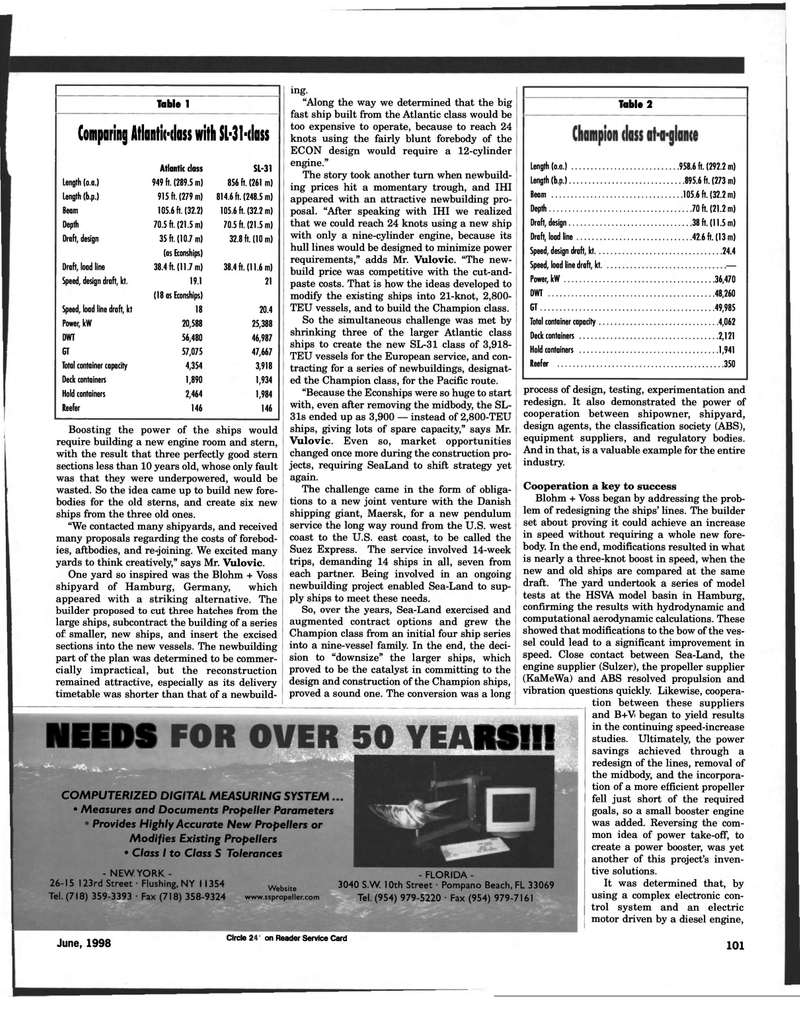
Page 99: of Maritime Reporter Magazine (June 1998)
Read this page in Pdf, Flash or Html5 edition of June 1998 Maritime Reporter Magazine
Table 1
Comparing Atlantic-class with SL-31- Atlantic class SL-31
Length (o.a.) 949 ft. (289.5 m) 856 ft. (261 m)
Length (b.p.) 915 ft. (279 m) 814.6 ft. (248.5 m)
Beam 105.6 ft. (32.2) 105.6 ft. (32.2 m)
Depth 70.5 ft. (21.5 m) 70.5 ft. (21.5 m)
Draft, design 35 ft. (10.7 m) 32.8 ft. (10 m)
(as Econships)
Draft, load line 38.4 ft. (11.7 m) 38.4 ft. (11.6 m)
Speed, design draft, kt. 19.1 21
(18 as Econships)
Speed, load line draft, kt 18 20.4
Power, kW 20,588 25,388
DWT 56,480 46,987
GT 57,075 47,667
Total container capacity 4,354 3,918
Deck containers 1,890 1,934
Hold containers 2,464 1,984
Reefer 146 146
Boosting the power of the ships would
require building a new engine room and stern,
with the result that three perfectly good stern
sections less than 10 years old, whose only fault
was that they were underpowered, would be
wasted. So the idea came up to build new fore-
bodies for the old sterns, and create six new
ships from the three old ones.
"We contacted many shipyards, and received
many proposals regarding the costs of forebod-
ies, aftbodies, and re-joining. We excited many
yards to think creatively," says Mr. Vulovic.
One yard so inspired was the Blohm + Voss
shipyard of Hamburg, Germany, which
appeared with a striking alternative. The
builder proposed to cut three hatches from the
large ships, subcontract the building of a series
of smaller, new ships, and insert the excised
sections into the new vessels. The newbuilding
part of the plan was determined to be commer-
cially impractical, but the reconstruction
remained attractive, especially as its delivery
timetable was shorter than that of a newbuild-
ing.
"Along the way we determined that the big
fast ship built from the Atlantic class would be
too expensive to operate, because to reach 24
knots using the fairly blunt forebody of the
ECON design would require a 12-cylinder
engine."
The story took another turn when newbuild-
ing prices hit a momentary trough, and IHI
appeared with an attractive newbuilding pro-
posal. "After speaking with IHI we realized
that we could reach 24 knots using a new ship
with only a nine-cylinder engine, because its
hull lines would be designed to minimize power
requirements," adds Mr. Vulovic. "The new-
build price was competitive with the cut-and-
paste costs. That is how the ideas developed to
modify the existing ships into 21-knot, 2,800-
TEU vessels, and to build the Champion class.
So the simultaneous challenge was met by
shrinking three of the larger Atlantic class
ships to create the new SL-31 class of 3,918-
TEU vessels for the European service, and con-
tracting for a series of newbuildings, designat-
ed the Champion class, for the Pacific route.
"Because the Econships were so huge to start
with, even after removing the midbody, the SL-
31s ended up as 3,900 — instead of 2,800-TEU
ships, giving lots of spare capacity," says Mr.
Vulovic. Even so, market opportunities
changed once more during the construction pro-
jects, requiring SeaLand to shift strategy yet
again.
The challenge came in the form of obliga-
tions to a new joint venture with the Danish
shipping giant, Maersk, for a new pendulum
service the long way round from the U.S. west
coast to the U.S. east coast, to be called the
Suez Express. The service involved 14-week
trips, demanding 14 ships in all, seven from
each partner. Being involved in an ongoing
newbuilding project enabled Sea-Land to sup-
ply ships to meet these needs.
So, over the years, Sea-Land exercised and
augmented contract options and grew the
Champion class from an initial four ship series
into a nine-vessel family. In the end, the deci-
sion to "downsize" the larger ships, which
proved to be the catalyst in committing to the
design and construction of the Champion ships,
proved a sound one. The conversion was a long
Table 2
Length (o.a.) 958.6 ft. (292.2 m)
Length (b.p.) 895.6 ft. (273 m)
Beam 105.6 ft. (32.2 m)
Depth 70 ft. (21.2 m)
Draft, design 38 ft. (11.5 m)
Draft, load line 42.6 ft. (13 m)
Speed, design draft, kt 24.4
Speed, load line draft, kt —
Power, kW 36,470
DWT 48,26
GT 49,985
Total container capacity 4,062
Deck containers 2,121
Hold containers 1,94
Reefer 350
NEEDS RS!!!
- NEW YORK -
26-15 123rd Street • Flushing, NY 11354
Tel. (718) 359-3393 • Fax (718) 358-9324
June, 1998
COMPUTERIZED DIGITAL MEASURING SYSTEM ...
• Measures and Documents Propeller Parameters
Provides Highly Accurate New Propellers or
Modifies Existing Propellers
• Class I to Class S Tolerances
Website
www.sspropeller.com
- FLORIDA -
3040 S.W. 10th Street • Pompano Beach, FL 33069
Tel. (954) 979-5220 • Fax (954) 979-7161
process of design, testing, experimentation and
redesign. It also demonstrated the power of
cooperation between shipowner, shipyard,
design agents, the classification society (ABS),
equipment suppliers, and regulatory bodies.
And in that, is a valuable example for the entire
industry.
Cooperation a key to success
Blohm + Voss began by addressing the prob-
lem of redesigning the ships' lines. The builder
set about proving it could achieve an increase
in speed without requiring a whole new fore-
body. In the end, modifications resulted in what
is nearly a three-knot boost in speed, when the
new and old ships are compared at the same
draft. The yard undertook a series of model
tests at the HSVA model basin in Hamburg,
confirming the results with hydrodynamic and
computational aerodynamic calculations. These
showed that modifications to the bow of the ves-
sel could lead to a significant improvement in
speed. Close contact between Sea-Land, the
engine supplier (Sulzer), the propeller supplier
(KaMeWa) and ABS resolved propulsion and
vibration questions quickly. Likewise, coopera-
tion between these suppliers
and B+V began to yield results
in the continuing speed-increase
studies. Ultimately, the power
savings achieved through a
redesign of the lines, removal of
the midbody, and the incorpora-
tion of a more efficient propeller
fell just short of the required
goals, so a small booster engine
was added. Reversing the com-
mon idea of power take-off, to
create a power booster, was yet
another of this project's inven-
tive solutions.
It was determined that, by
using a complex electronic con-
trol system and an electric
motor driven by a diesel engine,
Circle 273 on Reader Service Card 101

 98
98

 100
100
